Non-fiction
Non-fiction

The Letters of Audre Lorde and Pat Parker 1974-1989
Poets Audre Lorde and Pat Parker first met in 1969; they began exchanging letters regularly five years later. Over the next fifteen years, Lorde and Parker shared ideas, advice, and confidence through the mail. They sent each other handwritten and typewritten letters and postcards often with inserted items including articles, money, and videotapes.
The Letters of Audre Lorde and Pat Parker 1974-1989 gathers this unique correspondence in which Lorde and Parker discuss their work as writers as well as the intimate details of their lives, including periods when each lived with cancer. These letters are a rare opportunity to glimpse inside the minds and friendship of two great twentieth century poets.
Introduction by Mecca Jamilah Sullivan.

Hand That Touch This Fortune Will
Take my hand. Trace the lines on my palm with your fingers. What size and shape are they? Take note of their form: are they forked, tasselled, wavy, chained, broken? Now examine my fingers. Tell me my disposition; tell me what beholds me.
Mapping the hand as cosmos as clinic as history as biography, hand reading is a technique suspended between medical and mystical judgement, empirical diagnosis and speculative divination. This book weaves the lives and work of the ‘reader’ and the ‘read’ together in an intricate fabric. The central ‘reader’ is Charlotte Wolff (1897–1986), a friend of Walter Benjamin, Helen Grund, and Ernst Schoen, who after fleeing from Germany’s new regime in 1933, took up hand reading in Paris to make ends meet. The ‘read’ are anonymous acrobats, dancers, and department-store managers, and members of the avant-gardes of Paris and London, from Antonin Artaud to Romola Nijinsky, Marcel Duchamp to Virginia Woolf. Arranged as an index, this book is both a guide to the techniques of hand reading and a critical theory of its history and practice, mixed with Wolff’s later work as a theorist of gender and sexuality.
"Hand That Touch This Fortune Will is a study devoted to friendship, refracted through the portal of the upturned palm. Charlotte Wolff met the world by examining what was written on the hands of the times. What did she read in the landscapes of this intimate organ of touch, and what, through reading, was she fatally unable to see? Through a gentle fragmentation reminiscent of The Arcades Project, Dolbear acts as a thoughtful guide through fascinating and nearly forgotten passages in the European history of palmistry under late capitalism—along with all the political uncertainties and faggy gestures that formed its nimbus. With extraordinary attention to the peculiar experiments in living that have scarcely left a trace in the archive, Hand That Touch gathers the reader around those bars, clinics, and drawn curtains, where, under the shadow of fascist diagnosis, the occult comes palm to palm with the queer past." — M. Ty
Each book holds a very lovely insert of a hand reading chart, designed by Ana Cecilia Breña and Sam Dolbear. Printed on tracing paper, it allows the reader to read their hand as they read the book.
Sam Dolbear was a Fellow at the ICI Berlin Institute for Cultural Inquiry in Berlin from 2020 to 2024. His research addresses the life and work of Walter Benjamin and those around him. He has taught and published widely, including, with Esther Leslie, Dissonant Waves: Ernst Schoen and Experimental Sound in the 20th Century (2023). He is a co-founder of the sound and radio collective MayDay Radio.
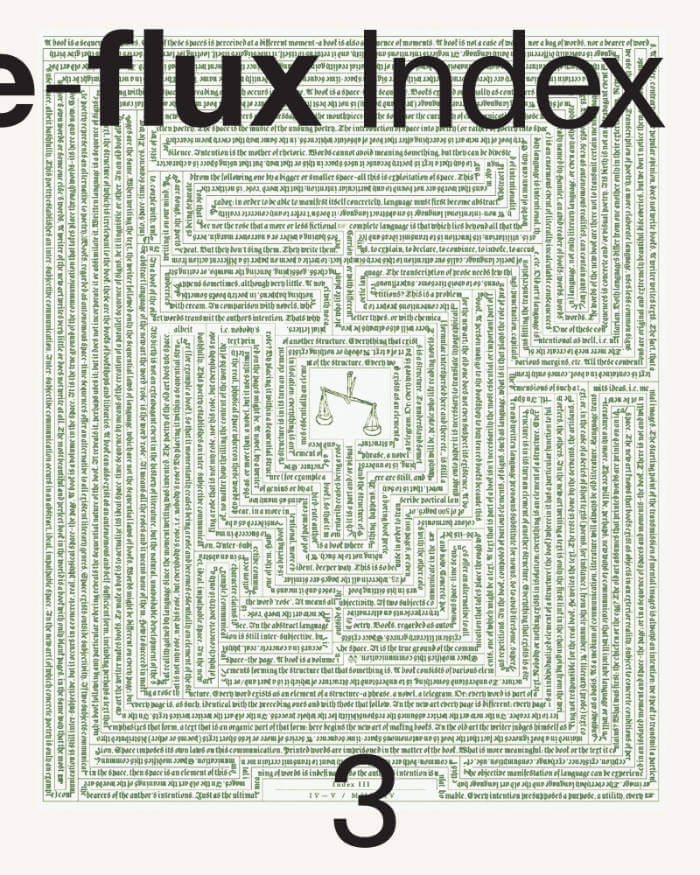
e-flux Index #03
76 contributions from an international selection of critics, artists, poets, architects, filmmakers, and theorists, published by e-flux between April–May 2024, arranged into 11 thematic chapters—ranging from the live question of cultural censorship through to the role of diagrams and notation in contemporary artistic practice.
540 pages long, this volume includes contributions from authors, artists, architects, filmmakers, poets, and theorists from many parts of the world. Ulises Carrión once declared that "In the new art every book requires a different reading"—an attitude which the Index here adopts in its approach to contemporary culture.
Contributions by Kwabena Appeaning Addo, Kimberly Alidio, Shouka Alizadeh, Corina L. Apostol, Aram, Arnavaz, Andrius Arutiunian, Robert Ashley, Goli Baharan, Stephanie Bailey, Oliver Basciano, Merve Bedir, Silvia Benedito, Pietro Bianchi, Alessandro Bosetti, Arno Brandlhuber, Nathan Brown, Boris Buden, Harry Burke, Rocio Calzado, Matevž Čelik, Adeline Chia, Ted Chiang, Canada Choate, Jace Clayton, Kim Cordóva, Ana Dana Beroš, Dasgoharan, Miri Davidson, Nuzhan Didartalab, Travis Diehl, Brian Dillon, Maria Dimitrova, Ben Eastham, Ren Ebel, Elaheh, Ludwig Engel, Future Foodscapes Research Unit, Ghoncheh Ghavami, Olaf Grawert, Boris Groys, Maddie Hampton, Negar Hatami, Jörg Heiser, Sandi Hilal, Daisy Hildyard, Juan José Santos, Nicole Kalms, Biljana Kašić, Tamta Khalvashi, Alina Kolar, Mo Michelsen Stochholm Krag, Cat Kron, Agnieszka Kurant, Michał Libera, R.H. Lossin, Rômulo Moraes, Daniel Muzyczuk, Nahal Nikan, Tausif Noor, Bahar Noorizadeh, Alice Notley, Joe Osae-Addo, Parva, Octave Perrault, Alessandro Petti, Andreas Petrossiants, Filipa Ramos, Jacques Rancière, Robida, Aoife Rosenmeyer, Mika Savela, Debora Silverman, Daniel Spaulding, Jonas Staal, Kerstin Stakemeier, Ben Vida, Anthony Vidler, McKenzie Wark, Katrina Wiberg, Kaelen Wilson-Goldie, Jenny Wu, Osman Can Yerebakan, Vivian Ziherl.

Understanding Molecular Typography
Molecular typography is the study of the chemical and physical underpinnings of letters. All characters are formed from seven basic atomic building blocks, known as typtoms. These typtoms come together in various combinations and configurations to form letters, numbers, and punctuation. Typtoms are not just theoretical tools for exploring the anatomy of type, but actual particles. Letters are molecules.
H.F. Henderson’s work, Understanding Molecular Typography, originally published in 1992, was a seminal work in the field. By condensing information pulled from nearly forty years of publications from the top molecular typographic scientists, Henderson made the science approachable to the everyday American for the first time. Part primer, part field guide, it lays out the basic principles, followed by detailed diagrams of the molecular formation of letters, numbers, and punctuation. A conclusion sums up the field of molecular typography to date, and a comprehensive bibliography provides valuable reference for the reader looking to learn more.
With the demise of the field of molecular typography as a whole in the mid-to-late ‘90s, (perhaps even due to its increased popularity brought on by Henderson’s work), Understanding Molecular Typography ran out of print, and has long since been forgotten. Peculiar as it may be, molecular typography is nevertheless a science worthy of being brought back to mainstream attention, if for no other reason than demonstrating humanity’s frequent scientific misconceptions throughout history. This reprint edition, with a new introduction by Woody Leslie, seeks to do just that.
"Until Henderson's incredible analysis, no one had created a conceptual framework sophisticated enough to do the analytic work in graphical physics that the alphabet required if it was to be fully understood. True, some of the Russian futurists, like Ilia Zdanevich, in their examinations of the properties of language, had begun to grasp the vague outlines of a modern scientific approach to molecular components, to the formation of compounds, and their behavior as chemical substances, within the structure of poetics. But Henderson's research was comprehensive and the results nothing short of astonishing." —Johanna Drucker

Issue Two: Becoming-ÊT/RE
Without intending it to be this way, Becoming’s magazine always appears when something big is changing for us. The first came at the very beginning, as a magazine published by our old record label, the second came just before we opened our Publishing House. Now, as we enter a new era, this magazine, the fruit of the Becoming Tree, is ripe enough to fall.
This issue is dedicated to the first-born of Becoming, a record label named Eternal/Return. We are using ÊT/RE to return to our centre, Music. Yet, we have a specific take on music that we wish to dedicate ÊT/RE to: we want to view music as a matter of world- building, of utterance, invocation— music is the second fire of Prometheus, we must carry it into the dark as we would a flame. Music is arcane; it is a ritual of summoning, of calling a forth a future—it is with sound that we create new spacetimes, and with music we create new worlds. It is hard to talk about music without talking about everything else. So that's what we did.
Featuring Charles Mudede, Female Wizard, Mystiki Fleva, Rose Laurel, Ibrahim Alfa Jnr, IOLI, Palais Sinclaire & 0nty

Christian Eschatology of Artificial Intelligence: Pastoral Technologies of Cybernetic Flesh
The book tracks the overlap of various “regimes of truth” from the Greco- Roman period through to the AI and cybernetic period, in order to present a continuity that ties together Christian Pastoralism and Neoliberal Self-Governance. The result is a fascinating and detailed examination of western hegemonial doctrines and signs, such as the Logos, the Flesh, and the Fall.
Vachnadze leaves us with no conclusion besides a certain feeling in our stomachs, a feeling that often comes when someone makes you aware of something fascinating, but deeply unnerving. The author weaves scripture and theory together in a way which can be as exciting as conspiratorial fictions, but it is executed without compromising the respectable position he has established at the point where non meets sense.

Semiotics of the End: Essays on Capitalism and the Apocalypse
The apocalypse as such will not take place, as it is already finished. Today, there is no longer any difference between the end of the world and capitalism itself: from Britney Spears’ Till the World Ends to The Caretaker’s Everywhere at the End of Time, from Avenger’s Endgame to Donnie Darko, and all the way down to the internet’s Backrooms, the world never ends but is reproduced again and again according to the semio-logic of capital.
In contrast with Mark Fisher’s Capitalist Realism, Semiotics of the End is a manifesto for the imagination of another relationship with the end. If it is easier to imagine the end of the world than the end of capitalism, as Slavoj Žižek, Fredric Jameson, and Mark Fisher put it, it is only because we have not imagined anything yet. The end is just the beginning.
With an Afterword by Matt Bluemink
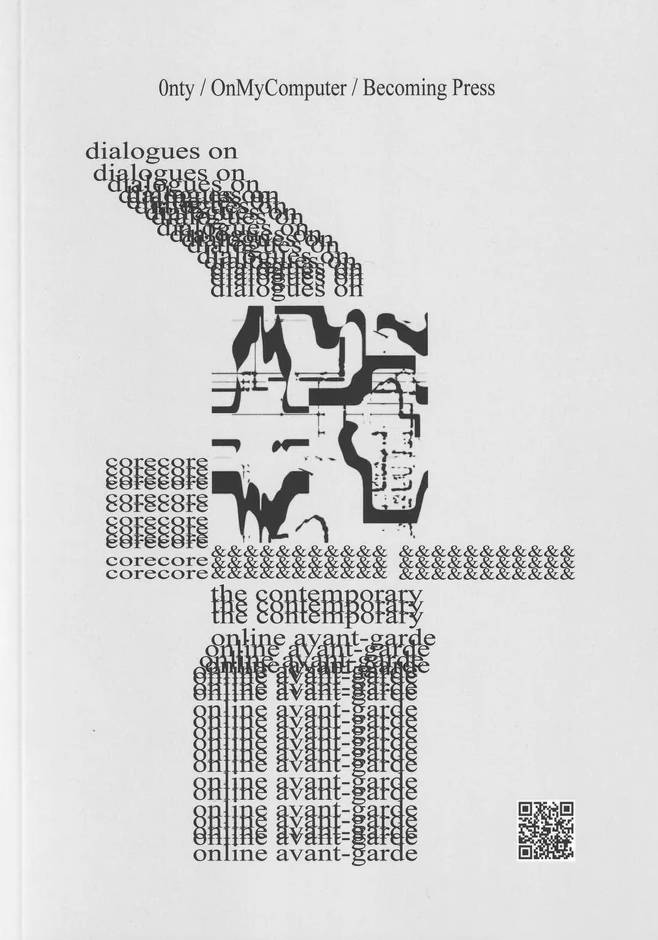
Dialogues on CoreCore & the Contemporary Online Avant-Garde
Featuring contributions from various artists and authors, including Louis Morelle, Persis Bekkering & Crisis Acting.
Dialogues on CoreCore & the Contemporary Online Avant-Garde gathers the work of over forty artists, writers, and philosophers to address the trajectories of the underground avant-garde digital art-world. A variety of topics and visual styles are represented in this anthology, but particular attention is paid to CoreCore, the DIY experimental filmmaking meta-trend which emerged on TikTok in the dusk of 2020. In part an anthology of critical and experimental essays, in part a curatorial artbook, in part a volume of conference proceedings, this text invites the viewer to explore the grassroots conference of a particular cybercultural moment.
This book follows on from the proceedings of All Things are Nothing to Us, a symposium on CoreCore and the Contemporary Online Avant-Garde, held on December 2nd. 2023, at the School of Visual Arts, NYC; organized by 0nty and OnMyComputer (Dylan Smith).
FEATURES WORK FROM:
0nty - Dylan Smith (OnMyComputer) - John-Robin Bold - Bebe_Crotte - Societyiftextwall - Aemmonia - Emonie Fay Chetwin (Xleepyfay) - Alice Aster - Anastasija Pavić - Anastasiia Pishchanska (shelestvetrovki) - Ash Ingram - ChaoticRhizomatic - Crisis Acting - Dana Dawud - Daniel Neeman - Edson Javier Rogil - Hunter Thompson - Joe Iovino (Levels of Nuance) - John DeSousa - John Michael - Jomel - Liam Harding (X._.pulp) - Louis Higgins - Louis Morelle - Maria Puglisi - Mason Noel - Mischa Dols - i0 xen0 - Nicholas Sanchez (Wonderful Cringe) - Nick Vyssotsky - Nikolaos Sakkadakis - Orion Arnold - Persis Bekkering - Redacted Cut - Reed McDonaldson - Rokas Vaičiulis - Rozzlyn Agnes K - Soham Adhikari - Uba - Zoey Solomon - Machine Yearning - Jordi Viader Guerrero - Tommaso Campagna - Kali Masoch

In the Delirium of the Simulation: Baudrillard Revisited
15 years after his death, the ghost of Jean Baudrillard lingers. Beyond just a pessimistic media theorist, the hyper-realist metaphysician of media and information may have become more relevant than ever before, and many of the concepts that Baudrillard left behind have become guiding principles in an ever deteriorating situation. Much of these ideas, from the Hyperreal to Cultural Nihilism, were repopularised in the last 15 years through such books as Capitalist Realism, in which the poster child for critical theory, Mark Fisher, appeared to have left the world a message, written in blood on the inside of our shared prison cell: Baudrillard was right all along!
This book is a serious diagnosis of the current form of capital, a profound excavation and presentation of the most important and helpful ideas that Baudrillard published from the unravelling of western philosophy, to a redefining of marxist theories of economics and capital, to a shift in critical theory that complies with quantum theory.
Published in collaboration with NON (Frankfurt)
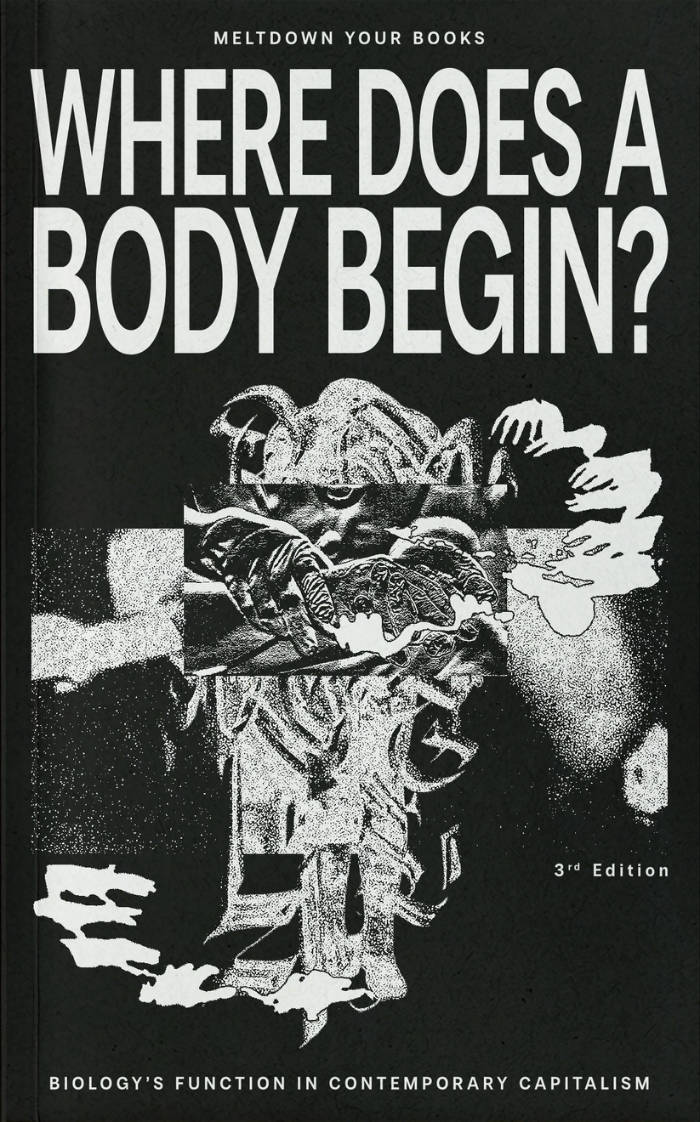
Where does a Body begin? Biology's function in contemporary capitalism
While presented as a contiguous work, the book is formed of different essays that have been dissected, recomposed with artificial connective tissue. The result lies somewhere between the rhizomatic continuity of a Body-without-Organs, and the disjointed assemblage of roadkill; either way, the question of where to even begin remains the same.
These essays each grow out of a particular resentment that developed through years of experience as a working-student of biology, but the task of the book was to transform this into something productive, something that sticks granular propositions into Biology like acupuncture needles. Inherent sexism within Biological research is, after all, not entirely disconnected to Pharmaceutical giants flooding the streets with opiates—and it is simply a writer’s hope that some well positioned words can remind enough people of how its all connected.
In what could be perceived as a philosophical turn, the importance of talking about science, as much as doing it, is re-entering the popular scientific consciousness, and it is high time, too. What was already getting bad under Biden, became catastrophic under Trump, and the infiltration into public research by private institutions and capitalist enterprises, which this book highlights, is proving dire. The capitalisation of all things bio, whether -yoghurt, -metric data or -logical institutions, is necrotic—MeltdownYourBooks didn’t flinch, they just grabbed the scalpel, dowsed the flesh in ethanol, and asked the question we all forget needs answering: where first, Doc?
Meltdown Your Books (M.Y.B.), the pen name, was made as a portmanteau of the seminal essay Meltdown by Nick Land, and the landmark film Throw Away Your Books, Rally in the Streets by Shuji Terayama. I chose the name, almost 3 years ago now, to reflect the political and digital black hole I saw hovering at the edge of contemporary media experience, and to present my work without the muddy veneer of personal identity. It has remained, since its inception, an anonymous project in only the loosest terms. The dedicated could always find my real identity, and some have, and so its anonymous character existed primarily as an element of presentation. Its anonymity existed to emphasize its deindividuated character. The things I discuss and emphasize under the M.Y.B. label are not items with definitive characteristics, they are collective experiences. M.Y.B. is something I cherish beyond self.

Affects & Dreams: a manual for Becoming
Affects & Dreams: a manual for Becoming, the first book authored by niko mas, is a relatively quick dive into the waters of Becoming; a schizo-guide to our publishing practice (why, how, and for what cause do we publish/transmit). We tell the story of a radio show that bridged our project Crossdressing Diogenes with our latest project, Becoming. In telling the story of how we arrived here at all, we have a chance to index all of the fields and domains that Becoming has entered into so far, and begins to maniacally draw lines through many subjects.
Some of the topics covered here include:
Images of Thought, Listening modes, Negativity and The Ear, Minimalism, Honest Electronics, Logocentrism, Metaphysics of Presence, Natural
Physics, Lumbung Radio, Rave Culture, Tripping, Radio Control Rooms, Analogical Transmissions, Anamorphoses, Insomniac Dream-Machines.

Technically Man Dwells upon this Earth
A brilliant and creative account of Thinking that cuts through the noise eminating from Artificial Intelligence and Art. In one fatal blow, the author makes the case that while Artificial Intelligence cannot make art, the majority of art that is produced today and throughout history is no different to what an Artificial Intelligence can produce. AI is therefore both an end to Art and its chance to begin again.
“The artist is cancelled: this is the time of art.”
With a Foreword by Louis Morelle.

Incubation: a space for monsters
New edition of this long out of-print classic of diasporic literature, featuring a forward by Eunsong Kim, an afterword by Emgee Dufresne, and new endnotes by Bhanu Kapil.
Incubation: a space for monsters is a formally innovative, hybrid-genre book that incorporates poetry and prose. Set in a shifting narrative environment, where human bodies, characters, and text are neither one thing nor another, this fragmentary-diaristic text journeys through the spaces in-between. Originally published in America in 2006 by Leon Works, and out of print for the last seven years, this is the first time this seminal text has been available in the UK.
Following protagonist Laloo – Cyborg, girl, mother, child, immigrant, settler – on a roadtrip through American landscapes, genre styles, and form, Incubation creates radical space for what is ‘monstrous’. Appropriating iconic American tropes, and the structure of Jack Kerouac’s On the Road, Incubation explores the challenges faced by immigrants in attaining such notions of freedom in so hostile an environment. In this fragmentary document there is a celebration in the cobbling together of lives; global in scope, with an intimate focus on interior voice, this landmark text evidences the early innovations and talents of this T.S. Eliot prizewinning author.
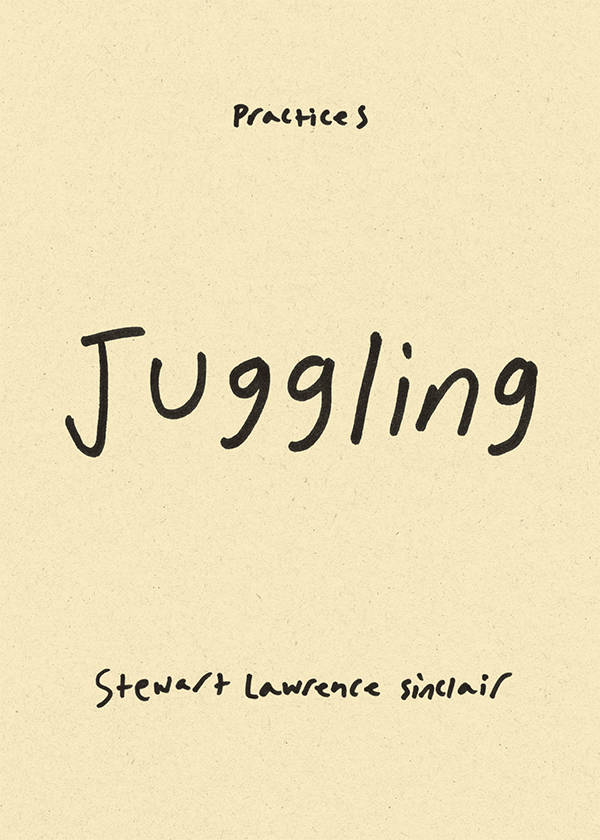
Juggling (Practices)
In Juggling , Stewart Lawrence Sinclair explores the four-thousand-year history and practice of juggling as seen through his life as a juggler. Sinclair—who learned to juggle as a child and paid his way through college by busking—shares his experiences of taking up juggling after an episode of suicidal ideation, his time juggling on the streets, and ultimately finding comfort in juggling during the COVID-19 pandemic. In many ways, this is a book about loss and recovery. From his own juggling story to clowns braving military checkpoints in Bosnia and Rwanda to perform in refugee camps to contemporary avant-garde performances, Sinclair shows how the universal language of juggling provides joy as well as a respite from difficulties during hard times.

Art as Experience
Based on John Dewey's lectures on esthetics, delivered as the first William James Lecturer at Harvard in 1932, Art as Experience has grown to be considered internationally as the most distinguished work ever written by an American on the formal structure and characteristic effects of all the arts: architecture, sculpture, painting, music, and literature.

How Are Artists Chosen? Exclusivity, precarious work and asymmetries in Art Competitions
Ramaya Tegegne, Tiphanie Blanc
The third volume of a new series of publications by the collective Wages For Wages Against, acting for better work conditions in the visual arts and against all forms of discrimination.
In 2022, the collective Wages for Wages Against applied for the Swiss Art Awards with the ambition of questioning the very model of the prize and its impact on artists. Art competitions are presented as real opportunities for artists, and arise throughout their careers, starting with school—entrance selection procedure, juried evaluations, diplomas and honors distinctions—, all the way to professional recognition—Meret Oppenheim Prize, Marcel Duchamp Prize, Turner Prize, etc. Only a handful of artists are selected for merit-based reward. However, this logic of sorting and validation upholds an entire system that reproduces inequalities and that perpetuates precarity in a milieu that is exclusive, and thus excludes. The institutional practices of communication and selection, as well as the validation of unpaid labor, favor certain artists at the expense of others. In this context, we surveyed the artists who participated, are considering participating, or are not participating in the Swiss Art Awards competition, in the interest of understanding their experiences and sharing their demands. In a broader sense, we wish to rethink the founding principles of artists' support policies and work to build a less competitive art world.
Wages For Wages Against (WFWA, wfwa.ch) is a a militant collective and a campaign for the fair remuneration of artists in Switzerland, better work conditions, and an alternative economy of the arts.
Contributions by Nathalie Stirnimann & Stefan Stojanovic and Amandine Gay.
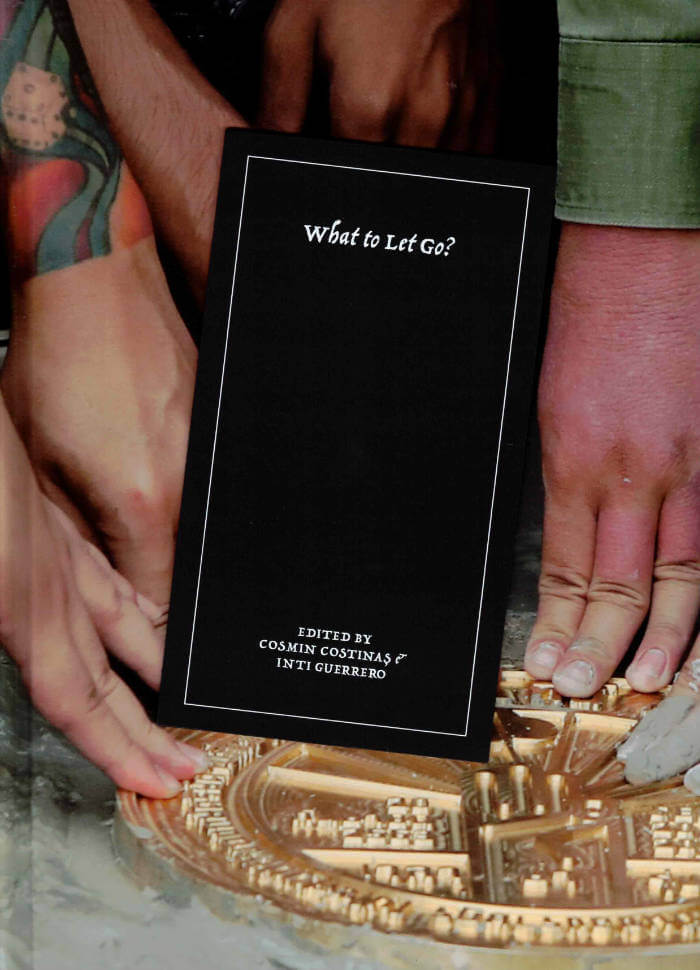
What to let go?
Cosmin Costinaş, Inti Guerrero
What gets counted within the category of heritage, and who gets to do the counting?
This book contributes to discussions about what counts as heritage now, who gets to do the counting, and broader related issues around the subject of cultural sovereignty. It unpacks historical narratives and political memories linked with objects, sites, and ceremonies that have been lost, looted, restituted, repatriated, revived, or reinvented. Through its diverse line-up of discourse, poetry, and original artistic contributions, it weaves together subjects and geographies that are not usually part of the same conversation —from plundered cultural belongings held in colonial collections, to processes of renaming or removing symbols of past eras— and considers how they relate in the context of recent social upheavals and political processes across continents.
In our era of dangerous revisionism, when history has become a battlefield for both the left and the right, we are asking: How can art reconfigure our collective foundational myths? And of what should we let go on the journey towards figuring it out?
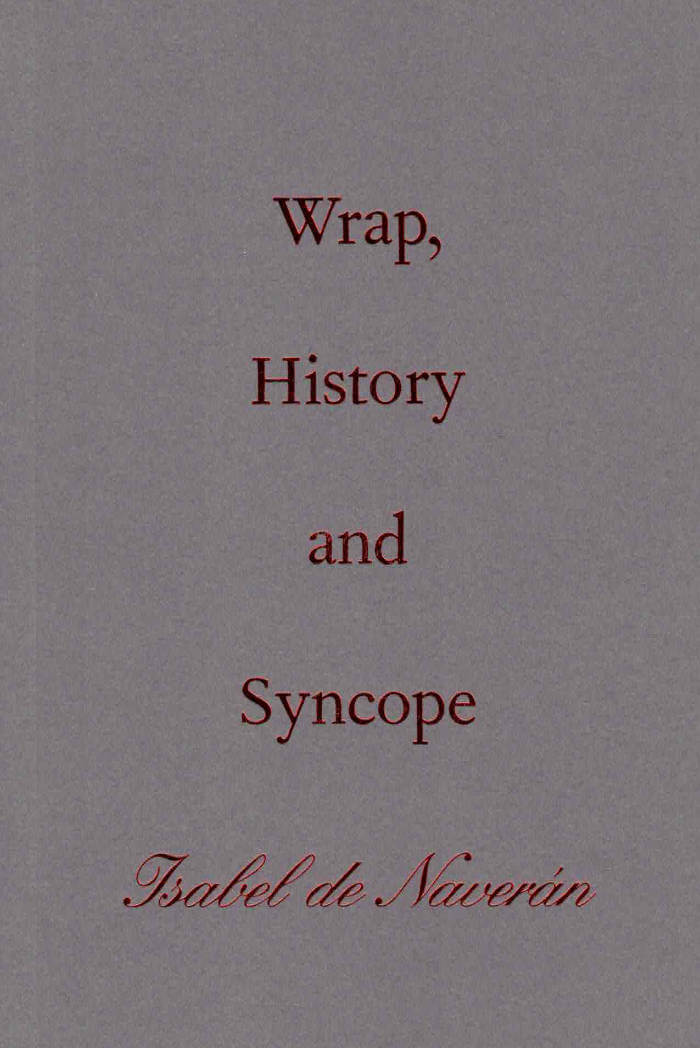
Wrap, History and Syncope
18 July 1936, Bayonne. After hearing the news of the Fascist uprising, the Spanish dancer and bailaora Antonia Mercé y Luque, known as La Argentina, suffers a syncope and dies in fateful synchrony with the Second Republic. History, and the artist’s body, have been seized and broken by the event.
In close dialogue with images and historical documents, Isabel de Naverán pursues the reverberations of that shock and how it resonates with collective pain and artistic translations (by Federico García Lorca, Gertrude Stein, Kazuo Ohno and others). How does history affect and move through bodies? How do living bodies carry and pass on cultural legacy and collective memory? What do these complex movements reveal about the present? Wrap, History and Syncope is an affective journey that invites the reader into tracing and revisiting other bodies, to ultimately dance their difference and multiplicity for oneself.
Isabel de Naverán is a writer and researcher. Concern with the passage and use of time is the backbone of her work, which focuses on bodily transmission and the examination of the concept of historical time by way of ephemeral and fugitive practices. She holds a PhD in art from the University of the Basque Country.
Translation from Spanish: Toni Crabb
Graphic design: Michaël Bussaer
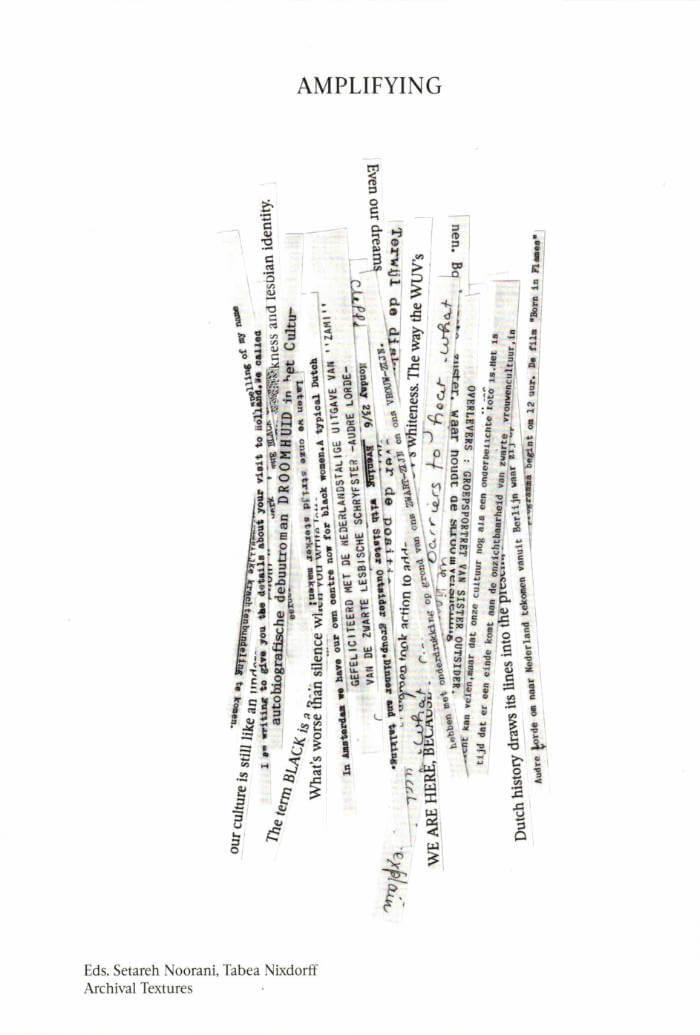
Archival Textures - Amplifying
Setareh Noorani, Tabea Nixdorff
The book Amplifying brings together written manifestations that trace the beginnings of Black feminism in the Netherlands. Amplifying means giving credit to, mentioning, over and over, and supporting the circulation of sources and authors that are formative for our thinking and practices. In the early 1980s, the political term “black” (zwart in Dutch) was introduced in the Netherlands to build alliances between women from different diasporic communities, who were faced with racism in their everyday lives.
Archival materials featured in this book include the original manuscript of the essay “Survivors: Portrait of the Group Sister Outsider” (1984), written by Gloria Wekker in collaboration with the Black lesbian literary group Sister Outsider, the seminal speech Statement of the Black Women’s Group (1983) by Julia da Lima, a contextualizing interview with Tineke E. Jansen and Mo Salomon (1984), excerpts from the book launch of Philomena Essed’s Everyday Racism (1984), and short texts authored by other Black feminist groups in the Netherlands, such as Zwarte Vrouwen & Racisme, Flamboyant, Ashanti, and Groep Zwarte Vrouwen Nijmegen.

Archival Textures - Posting
Carolina Valente Pinto, Tabea Nixdorff
The book Posting brings together a selection of feminist posters from Dutch archives to reflect on posting as an activist strategy, holding the potential to create counter-publics to mainstream culture and to fight against the erasure, exoticization, or tokenism of bodies and experiences that deviate from normative preconceptions.
As is the case for many professions, in the history of Dutch graphic design the absence of women, non-binary, queer, Black designers is striking. This doesn’t only point back to systematic processes of exclusion in the first place, but also to the biases at play regarding whose work is remembered and archived. While efforts have been made to add forgotten names to the existing canon, the many posters, flyers and other printed matter shelved in queer and feminist archives remind us to question the notion of single authorship altogether and instead study graphic design as a decisively collaborative and transdisciplinary practice, which is especially true for community-led and volunteer-based projects.
The posters featured in this book point to this rich landscape of feminist organizing, and were found at the International Institute of Social History and the International Archive for the Women’s Movement (IAV-Atria) in Amsterdam.
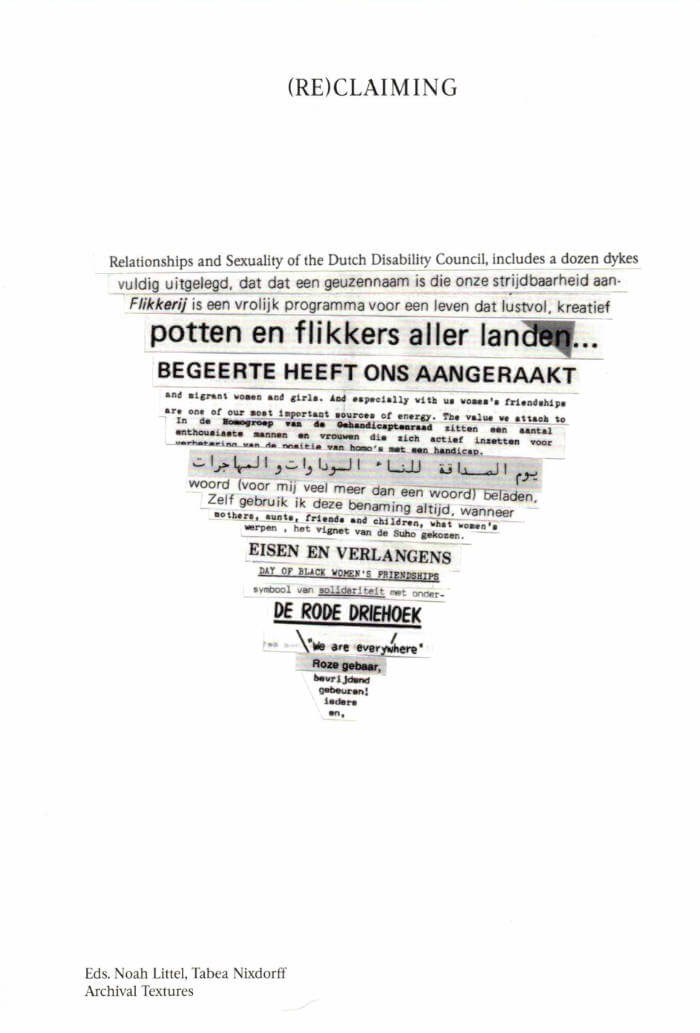
Archival Textures - (Re)claiming
The book (Re)claiming presents ways in which various queer and feminist communities and initiatives in the Netherlands have (re)claimed the triangle—along with other symbols, words and stories—and in doing so take up an empowering position in a hostile society.
Besides a collection of buttons, archival materials featured in this book include short statements and flyers by queer groups such as SUHO, Sjalhomo, Roze Front, Roze Driehoek, Roze Gebaar, Van Doofpot tot Mankepoot, Interpot/ILIS, Lesbisch Archief Amsterdam, Strange Fruit Vrouwen and Groep Zwarte Vrouwen Nijmegen, as well as a text by Karin Daan, the designer of the Homomonument in Amsterdam. With this selection, this book brings together queer, trans, crip, feminist, Jewish and Black perspectives on (re)claiming as an activist strategy.
Most of these materials were researched at IHLIA LGBTI Heritage in Amsterdam, with additions found at the International Institute of Social History and the International Archive for the Women’s Movement (IAV-Atria) in Amsterdam, and LAN Lesbisch Archief Nijmegen.

Experimental Translation
The history and future of an alternative, oppositional translation practice.
The threat of machine translation has given way to an alternative, experimental practice of translation that reflects upon and hijacks traditional paradigms. In much the same way that photography initiated a break in artistic practices with the threat of an absolute fidelity to the real, machine translation has paradoxically liberated human translators to err, to diverge, to tamper with the original, blurring creation and imitation with cyborg collage and appropriation.
Seven chapters reimagine seven classic “procedures” of translation theory and pedagogy: borrowing, calque, literal translation, transposition, modulation, equivalence, and adaptation, updating them for the material political and poetic concerns of the contemporary era. Each chapter combines reflections from translation studies and experimental literature with practical guides, sets of experimental translation “procedures” to try at home or abroad, in the classroom, the laboratory, the garden, the dance hall, the city, the kitchen, the library, the shopping center, the supermarket, the train, the bus, the airplane, the post office, on the radio, on your phone, on your computer, and on the internet.

National Letters: Languages and Scripts as Nation-building Tools
National Letters is the first book published by Letter Books. National Letters travels through the episodes of the past in which letters, languages, and scripts played an important role in creating nation-states and national identities. Through four case studies (Turkey, Israel, Georgia, Ethiopia), the main body of the book explores four languages and nations which were each, against all odds and for various reasons, able to develop and maintain their writing system throughout their entire history, up to the founding of their nation-state.
Edited and Designed by Marek Nedelka
Contributions and texts by Rusudan Amirejibi–Mullen, Ivo T. Budil, Birol Caymaz, Tomáš Garrigue Masaryk, Marek Nedelka, William Safran, Emmanuel Szurek
Postcard letterings by Jan Horčík, Seb McLauchlan, Anežka Minaříková, Jan Novák
Translations by Ian Mikyska and Sam Mackay
Copy-editing and proofreading by Aren Ock
Co-published with UMPRUM (Academy of Arts, Architecture & Design in Prague)

Mysterious Letters: Language, Science, and the Voynich Manuscript
Anežka Minaříková, Marek Nedelka
Mysterious Letters is a private investigation into the unsolved mysteries surrounding the Voynich Manuscript. The manuscript is considered to be a “UFO of a book world” as it was written in an unknown language and script, in an unknown location in the 15th century. The book features interviews and essays from various experts in different fields, all pondering the question of what it means to encounter something that remains beyond our comprehension in a world where all information and knowledge seem to be readily available.
Edited and Designed by Anežka Minaříková & Marek Nedelka
Essays by Anežka Minaříková, Arnošt Vašíček
Interviews and Conversations with Ivan Zelinka, Vladimír Matlach, Barbora Anna Janečková, and Reed Johnson
Copy-editing and proofreading by Aren Ock